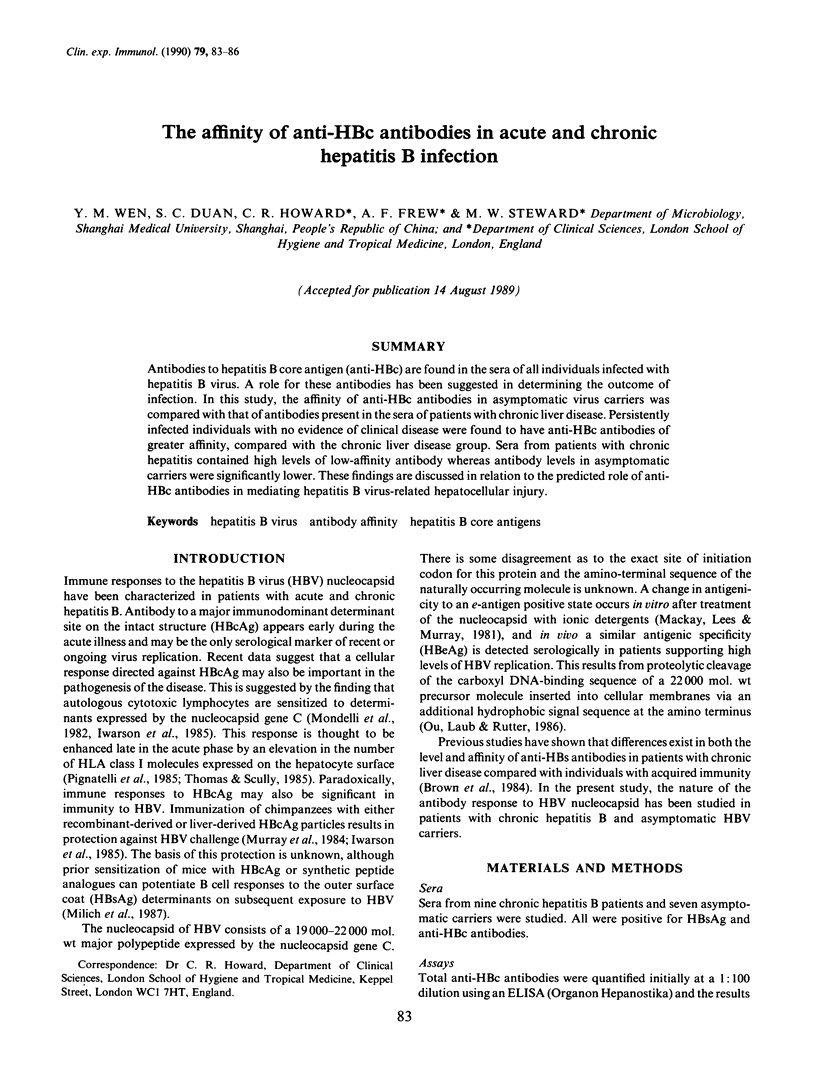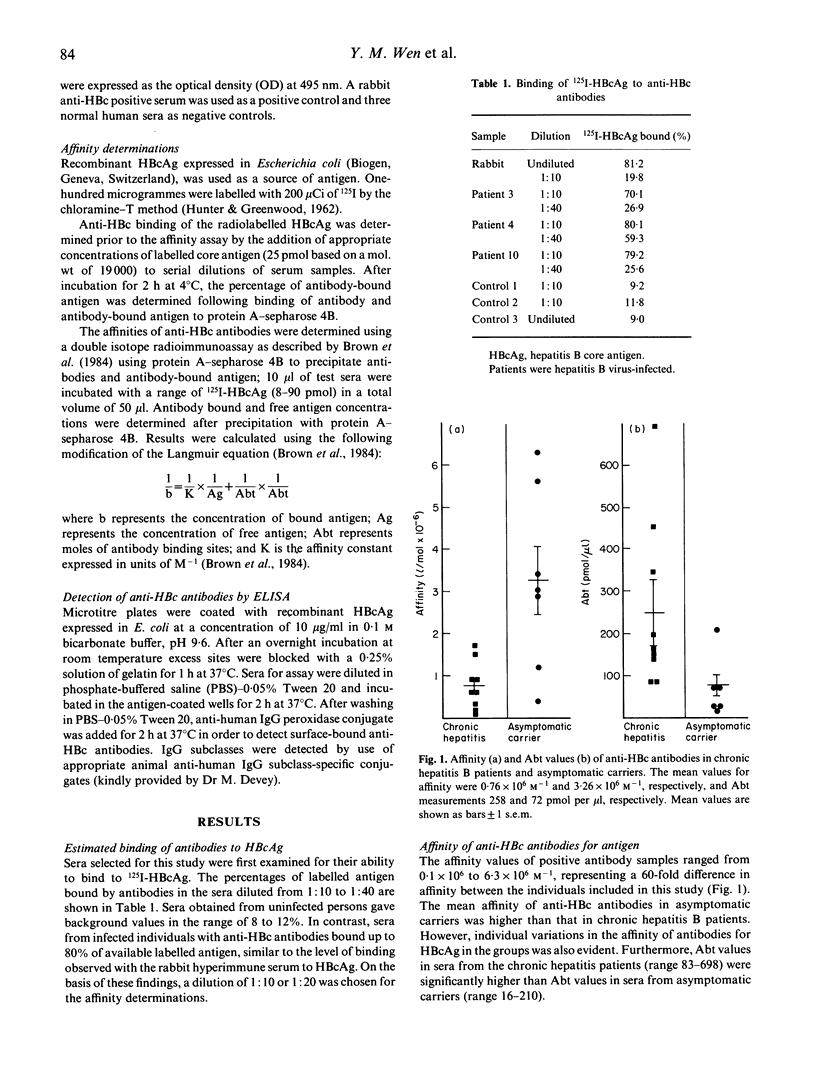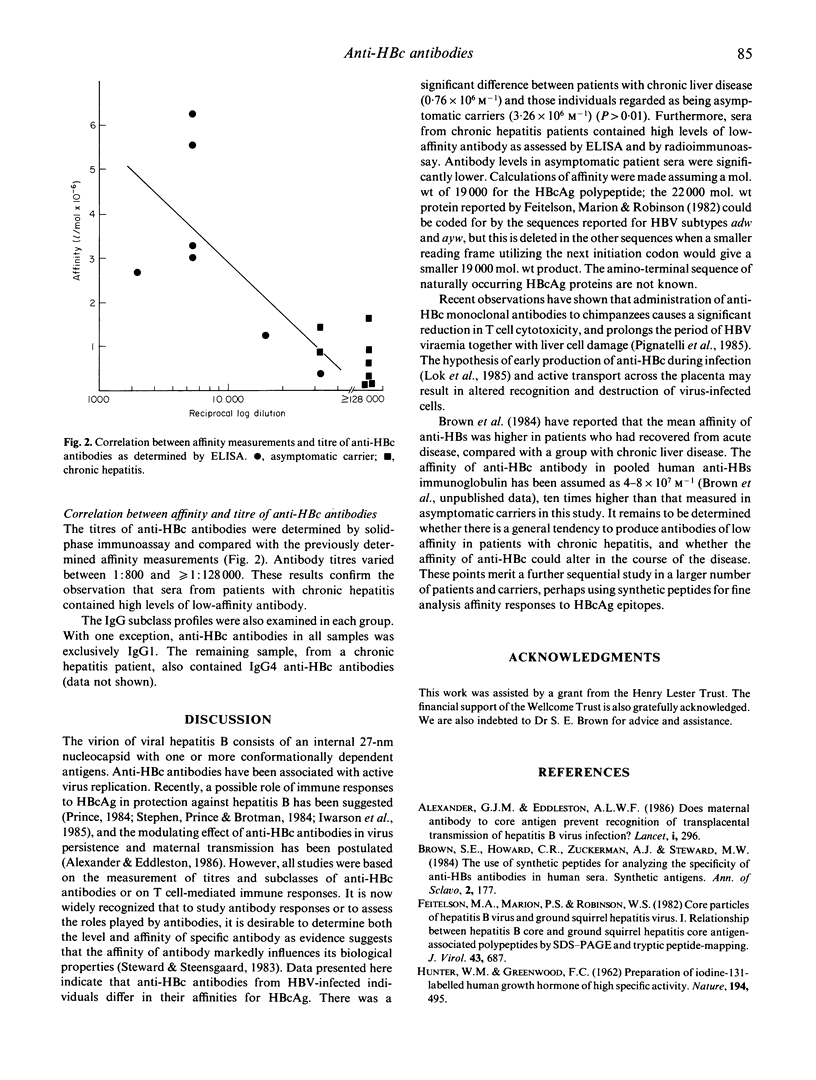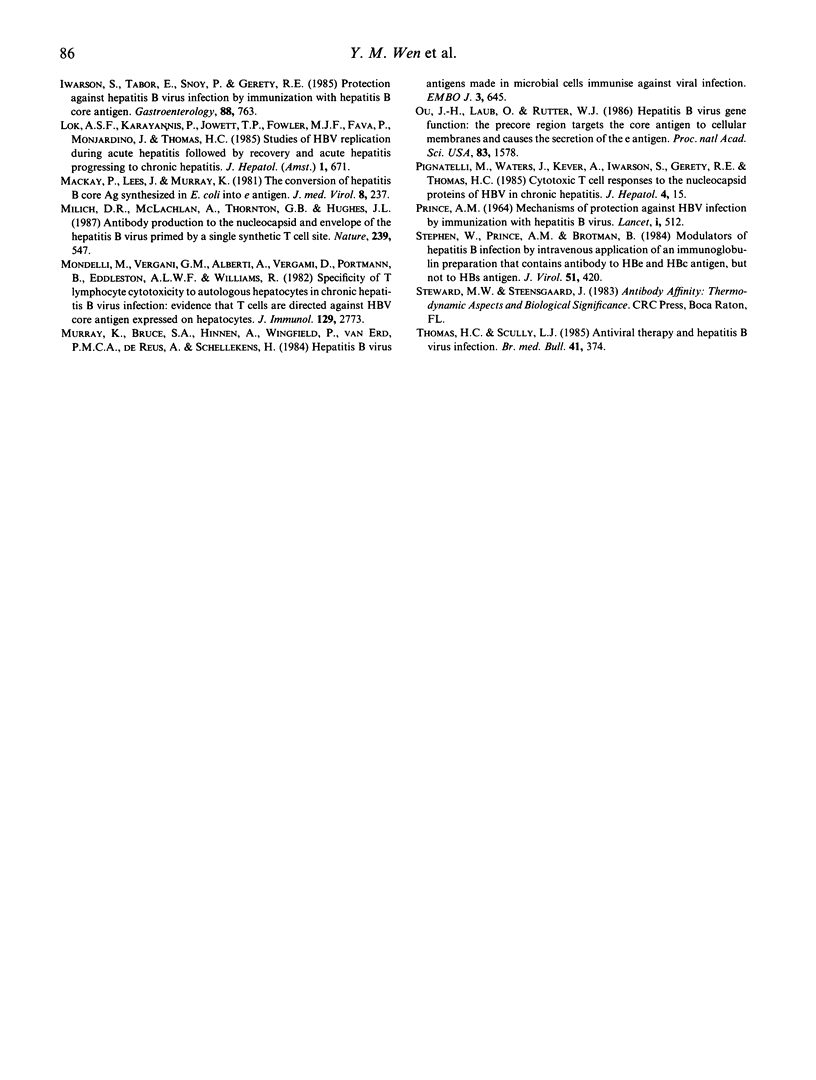Abstract
Antibodies to hepatitis B core antigen (anti-HBc) are found in the sera of all individuals infected with hepatitis B virus. A role for these antibodies has been suggested in determining the outcome of infection. In this study, the affinity of anti-HBc antibodies in asymptomatic virus carriers was compared with that of antibodies present in the sera of patients with chronic liver disease. Persistently infected individuals with no evidence of clinical disease were found to have anti-HBc antibodies of greater affinity, compared with the chronic liver disease group. Sera from patients with chronic hepatitis contained high levels of low-affinity antibody whereas antibody levels in asymptomatic carriers were significantly lower. These findings are discussed in relation to the predicted role of anti-HBc antibodies in mediating hepatitis B virus-related hepatocellular injury.
Full text
PDF



Selected References
These references are in PubMed. This may not be the complete list of references from this article.
- Alexander G. J., Eddleston A. L. Does maternal antibody to core antigen prevent recognition of transplacental transmission of hepatitis-B-virus infection? Lancet. 1986 Feb 8;1(8476):296–297. doi: 10.1016/s0140-6736(86)90829-9. [DOI] [PubMed] [Google Scholar]
- Brown S. E., Howard C. R., Zuckerman A. J., Steward M. W. The use of synthetic peptides for analysing the specificity and affinity of anti-HBs antibodies in human sera. Ann Sclavo Collana Monogr. 1984;1(2):177–185. [PubMed] [Google Scholar]
- Feitelson M. A., Marion P. L., Robinson W. S. Core particles of hepatitis B virus and ground squirrel hepatitis virus. I. Relationship between hepatitis B core antigen- and ground squirrel hepatitis core antigen-associated polypeptides by sodium dodecyl sulfate-polyacrylamide gel electrophoresis and tryptic peptide mapping. J Virol. 1982 Aug;43(2):687–696. doi: 10.1128/jvi.43.2.687-696.1982. [DOI] [PMC free article] [PubMed] [Google Scholar]
- HUNTER W. M., GREENWOOD F. C. Preparation of iodine-131 labelled human growth hormone of high specific activity. Nature. 1962 May 5;194:495–496. doi: 10.1038/194495a0. [DOI] [PubMed] [Google Scholar]
- Iwarson S., Tabor E., Thomas H. C., Snoy P., Gerety R. J. Protection against hepatitis B virus infection by immunization with hepatitis B core antigen. Gastroenterology. 1985 Mar;88(3):763–767. doi: 10.1016/0016-5085(85)90148-9. [DOI] [PubMed] [Google Scholar]
- Lok A. S., Karayiannis P., Jowett T. P., Fowler M. J., Farci P., Monjardino J., Thomas H. C. Studies of HBV replication during acute hepatitis followed by recovery and acute hepatitis progressing to chronic disease. J Hepatol. 1985;1(6):671–679. doi: 10.1016/s0168-8278(85)80010-6. [DOI] [PubMed] [Google Scholar]
- MacKay P., Lees J., Murray K. The conversion of hepatitis B core antigen synthesized in E coli into e antigen. J Med Virol. 1981;8(4):237–243. doi: 10.1002/jmv.1890080404. [DOI] [PubMed] [Google Scholar]
- Milich D. R., McLachlan A., Thornton G. B., Hughes J. L. Antibody production to the nucleocapsid and envelope of the hepatitis B virus primed by a single synthetic T cell site. Nature. 1987 Oct 8;329(6139):547–549. doi: 10.1038/329547a0. [DOI] [PubMed] [Google Scholar]
- Mondelli M., Vergani G. M., Alberti A., Vergani D., Portmann B., Eddleston A. L., Williams R. Specificity of T lymphocyte cytotoxicity to autologous hepatocytes in chronic hepatitis B virus infection: evidence that T cells are directed against HBV core antigen expressed on hepatocytes. J Immunol. 1982 Dec;129(6):2773–2778. [PubMed] [Google Scholar]
- Murray K., Bruce S. A., Hinnen A., Wingfield P., van Erd P. M., de Reus A., Schellekens H. Hepatitis B virus antigens made in microbial cells immunise against viral infection. EMBO J. 1984 Mar;3(3):645–650. doi: 10.1002/j.1460-2075.1984.tb01861.x. [DOI] [PMC free article] [PubMed] [Google Scholar]
- Ou J. H., Laub O., Rutter W. J. Hepatitis B virus gene function: the precore region targets the core antigen to cellular membranes and causes the secretion of the e antigen. Proc Natl Acad Sci U S A. 1986 Mar;83(6):1578–1582. doi: 10.1073/pnas.83.6.1578. [DOI] [PMC free article] [PubMed] [Google Scholar]
- Pignatelli M., Waters J., Lever A., Iwarson S., Gerety R., Thomas H. C. Cytotoxic T-cell responses to the nucleocapsid proteins of HBV in chronic hepatitis. Evidence that antibody modulation may cause protracted infection. J Hepatol. 1987 Feb;4(1):15–21. doi: 10.1016/s0168-8278(87)80004-1. [DOI] [PubMed] [Google Scholar]
- Prince A. M. Mechanism of protection against hepatitis B infection by immunisation with hepatitis B virus cores. Lancet. 1984 Mar 3;1(8375):512–512. doi: 10.1016/s0140-6736(84)92879-4. [DOI] [PubMed] [Google Scholar]
- Stephan W., Prince A. M., Brotman B. Modulation of hepatitis B infection by intravenous application of an immunoglobulin preparation that contains antibodies to hepatitis B e and core antigens but not to hepatitis B surface antigen. J Virol. 1984 Aug;51(2):420–424. doi: 10.1128/jvi.51.2.420-424.1984. [DOI] [PMC free article] [PubMed] [Google Scholar]
- Thomas H. C., Scully L. J. Antiviral therapy in hepatitis B infection. Br Med Bull. 1985 Oct;41(4):374–380. doi: 10.1093/oxfordjournals.bmb.a072079. [DOI] [PubMed] [Google Scholar]


